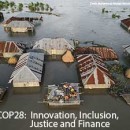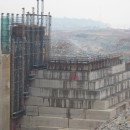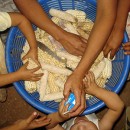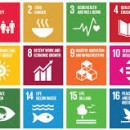

Systemic inequalities based on gender, race, income and geography are mirrored in the digital realm and leave many women, especially the poor and the rural, trailing behind Africa’s tech transformation.


Migrants as Messengers is a peer-to-peer messaging campaign by the
International Organization for Migration (IOM) where returning migrants share with their communities and families the dangers, trauma and abuse that many experienced while attempting irregular migration.


Climate change is on us. Parts of the planet are burning up. Heatwaves across the northern hemisphere have dried vegetation and withered crops. Forests are ablaze in North America, Europe and Asia – even as far north as the Arctic Circle. The polar ice caps are melting and sea levels are rising. Massive storms and floods have devastated communities. Deserts continue relentlessly to encroach. And the extraordinarily hot spells this summer followed on from the extraordinarily cold spells of last winter. In 2018, extreme weather is the order of the day.


The world has witnessed innumerable images of the long walk to 'freedom' of Rohingya women, children and men. Some trudged for endless hours and days, many carrying elderly parents and babies in baskets, with the women suffering the unimaginable trauma having been victims of rape, torture and harassment.


Irrigated green fields of vineyards and monoculture crops coexist in Brazil’s semiarid Northeast with dry plains dotted with flowering cacti and native crops traditionally planted by the locals. Two models of development in struggle, with very different fruits.


In Meghalaya, India’s northeastern biodiversity hotspot, all three major tribes are matrilineal. Children take the mother’s family name, while daughters inherit the family lands.


Displaced pastoralists gather around newly arrived drums of brown water as a water truck speeds off to make further deliveries to settlements that have sprung up along the main road running out of Gode, one of the major urban centers in Ethiopia’s Somali region.


As hundreds of thousands flee their homes in northeastern Nigeria to seek safety from intensifying conflict between Boko Haram and the Nigerian military, the IKEA Foundation has given Médecins Sans Frontières (MSF) €1 million to provide lifesaving medical assistance.


To the world they are known as “refugees”. Nameless, faceless, all the same. But each of them have a different story to tell, of their lives, who they lost, and how they got here. Fleeing from the devastating conflict in the Central African Republic (CAR), today they are rebuilding their lives, one day at a time, in a camp in Cameroon. UN Women supports economic and social rehabilitation to some 6,250 vulnerable women and survivors of sexual and gender-based violence there. These are some of their stories.


More than 2.2 billion people in Asia rely on agriculture for their livelihoods, but the Asian Development Bank warns that stagnant and declining yields of major crops such as rice and wheat can be ultimately linked to declining investments in agriculture. Public investments in agriculture in India, for instance, have been roughly the same since 2004.


While agriculture could be the driving force to lift millions of Africans out of poverty and alleviate hunger, its full potential remains untapped. For example, only between five and seven percent of the continent’s cultivated land is irrigated, leaving farmers vulnerable to climate shocks like the devastating El Nino-driven drought in southern Africa. That's why international agencies like the U.N. Food and Agriculture Organization (FAO) are forging key partnerships to enhance agricultural production, sustainable natural resource management and increased market access.


At the beginning of the 19th century there were 40, 000 tigers in the world. Today, around 4,000 tigers are left in the wild globally, 2,226 of which are in India.


As the World Farmers' Organization meets for its annual conference in Zambia to promote policies that strengthen this critical sector, IPS looks at how farmers across the globe are tackling the interconnected challenges of climate change, market fluctuations, water and land management, and energy access.


Inside a health clinic run by the Catholic Daughters of Saint Anne, a nurse wraps a special tape measure around the upper arm of 2-year-old Rodas cradled in her mother’s arms. The tape reads yellow, meaning “moderately” malnourished, according to the attending nurse.


Despite a cultural, historical and linguistic identity quite distinct from the rest of Africa, Ethiopia never became a major tourist destination on the continent.


Ugandan farmers are increasingly inter-planting coffee, the country’s primary export, and banana, a staple food, as a way of coping with the effects of climate change.


On a sunny November day in Addis Ababa the courtyard of the Jesuit Refugee Service (JRS) centre is packed with people—some attend a United Nations High Commissioner for Refugees reception clinic, others get essential supplies, while students attend classes, and many simply play volleyball, table football or dominoes to pass the time.


When health officer Kennedy Mulenga was faced with a male patient developing breasts at the remote Ngwerere Clinic 30km north of the Zambian capital, Lusaka, he logged onto Virtual Doctors to get help solving the medical mystery.


At the dawn of Indian Independence, Government of India’s commitment to food security – in addition to the impact of the Bengal Famine – was haunted by corruption, hoarding and mismanagement, resulting in ongoing food insecurity among the indigenous people in Tamilnadu and Orissa that lasted for more than five decades,


After 15 years of trying to meet the targets set out to address extreme poverty, the 193 member states of the United Nations have almost reached consensus on a more broad-reaching group of goals.


The importance of mangroves in protecting coastal areas under threat due to sea level rise caused by climate change may have been underestimated, according to new research.




































